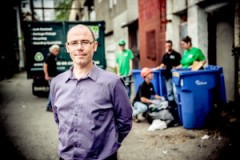Workers need protection when a clean-up job could possibly include used needles, human body fluids, animal corpses, and piles of rodent poo.

Clean-up crews get ready to disinfect and deodorize. Photo by Daisy Goggs.
Workers in such situations – not for the faint of heart – are required by BC’s Occupational Health and Safety Regulation to use personal protective equipment (PPE) that includes appropriate respirators, coveralls, rubber gloves, and protective footwear – not to mention training and supervision.
CleanStart workers use this gear, training, and supervision when they sort and remove junk from hoarding situations in homes and hotels in Vancouver’s Downtown Eastside. In general, it’s building owners, advocacy groups, and family members who request their services.
“They normally call at a point of crisis when the tenant or home owner is facing an eviction notice or the fire department is enforcing safety regulations,” said CleanStart founder and CEO Dylan Goggs.
Not everyone can handle this type of clean-up job. But the workers in this program “don’t shy away from any kind of difficult situations,” Dylan said, who described the team of workers as neighbourhood residents who have a good idea of what they’re walking into on a job. Most receive disability benefits from the BC government and their on-call work with CleanStart allows them to earn top-up income while contributing a valuable service to their community.
Exposure control plans
Dylan said CleanStart used information from WorkSafeBC to develop exposure control plans for hantavirus from rodents and bloodborne pathogens from needle-stick injuries. Controlling Exposure: Protecting Workers From Infectious Disease is one source of information on this topic.
When workers risk exposure to harmful substances, employers need an Exposure Control Plan that identifies a risk, and how it will be assessed and controlled. This includes training and education for workers, and, depending on the situation, it might also include written work procedures, hygiene facilities, health monitoring, and other documentation.

CleanStart founder and CEO Dylan Goggs. Photo by Daisy Goggs.
Dylan started the company five years ago when he was volunteering in Vancouver’s Downtown Eastside and recovering from a spinal tumour that left him with permanent nerve damage in his leg.
“My life just changed – and suddenly I was in this whole situation of realizing that I was going to need support for the rest of my life,” Dylan said. “I wasn’t even sure if I could work again. At the same time, I was volunteering in the Downtown Eastside, and it just kind of clicked for me that we could actually make something work to address reducing waste and creating employment.”
Thanks to Dylan for sharing the story.


